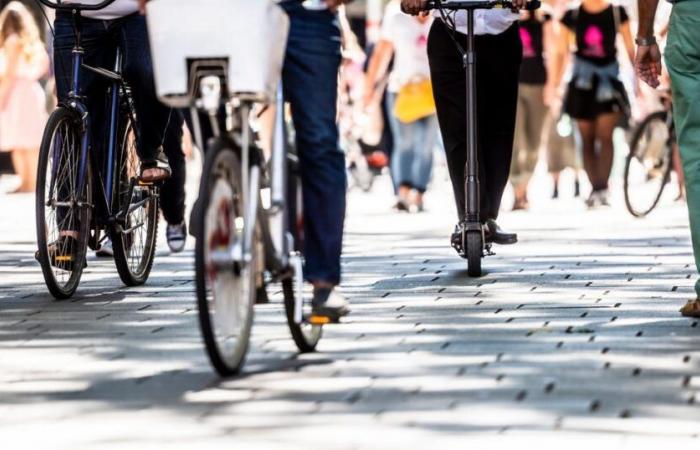
Nantes associations are concerned about the problems of cohabitation caused by the proliferation of cyclists in the city center. A population of two-wheelers which would encroach on the movements of pedestrians.
Le Figaro Nantes
Who's afraid of the big bad bike? In Nantes, motorists have long learned to share public space with this method of “soft mobility” particularly praised by local elected officials. The triumphant cyclists of the urban area, however, would have succumbed, in the euphoria of their growth, to the same vices hitherto vilified among the drivers: monopolization of shared paths, insults, arrogance, endangering others… A displayed superiority which would be imposed on the only users who are even more fragile than frail two-wheelers: pedestrians.
«L’explosion of cycling in Nantes was accompanied by a significant increase in use conflicts in the city center, particularly at the initiative of cyclists. observes Jérôme Dyon, president of the Nantes Travel and Environment Association (ANDE). “Some of these two-wheelers display an openly contemptuous attitude, zigzag at full speed between pedestrians or, on the contrary, rush in a straight line even if it means putting people in danger – and this even in areas where they are supposed to ride at speed. not”he adds. The entire city center would be affected by the hazards of this cohabitation which seems to follow the exact opposite of the mood of the sky, all the more stormy when the sun is shining – and the cyclists are out. This urban planner specializing in roads identifies more openly contested areas, such as the surroundings of the castle of the Dukes of Brittany, those of the Nantes station or even the quays of the Erdre, near the Loire-Atlantique prefecture. “This mentality is more and more tiring and unpleasant, he laments. It’s as if they are taking all the rights because they have made the effort not to take their car!”
A “blind spot”
Aware of the problems of bicycle-pedestrian cohabitation, the Nantes town hall has installed new signs in recent months reminding the priorities to be respected according to the sectors. “A gesture that goes in the right direction, even though these signs remain, for the moment, little respected”recognizes Jérôme Dyon, while deploring that pedestrians remain, despite everything, “the blind spot, even the black hole of the rearrangement of traffic plans”. Thus, the work on Boulevard Dalby, intended to reduce the axis to one-way traffic accompanied by a cycle path «masterful» should be at the expense of cars as much as pedestrians, argues ANDE, citing in particular the narrowness of the roads and the number of intersections.
The metropolis (of Nantes) has taken such a turn, going against the excesses of the all-car approach advocated fifty years ago, that it now falls into the opposite ideology of cycling taken to the extreme.
Patrick Eade, 60 million pedestrians
However, these projects are multiplying in the city, in accordance with the community's plan, aiming to make Nantes “the laboratory of 21st century cycling citiese century”. To do this, an envelope of 115 million euros was voted to develop, among other things, 50 kilometers of new “readable and secure master channels” reserved for bicycles, with the objective of quadrupling – by 2026 – the share of bicycles in metropolitan travel. The approach makes Jérôme Dyon boil: “These are purely dogmatic ambitions, which Nantes ecologists managed to impose on the socialist majority during the last municipal elections. But we should come back to earth and engage in better consultations on these developments”.
Also read
“Once a scaffolding has been erected, we discover other elements to review”: the difficult and expensive construction site of the Nantes cathedral
Indeed, opposing cycling restrictions in Nantes is not synonymous with an anti-cycling position. “It’s a question of measurement,” notes Patrick Eade, of the 60 million pedestrians association. “We do not want to pit pedestrians and cyclists against each other, because these two types of travel are complementary. But the metropolis has taken such a turn, going against the excesses of the all-car approach advocated fifty years ago, that it now falls into the opposite ideology of cycling taken to the extreme.explains this Nantes mobility specialist. He also fears for the safety of pedestrians on the busiest roads in the city center to the point of imagining – with a yellow laugh – “pedestrian flashers” to ensure the safety of passers-by. “The city lets users manage themselves, it’s a shame. We should rather demonstrate more pedagogy, then start to sanction if necessary”.
Requested by Le Figarothe Nantes association Place au vélo, partner of the town hall, concedes the existence of “problems of incivility linked to difficult cohabitation, in some areas where great confusion reigns, unfortunately maintained by the city. She claims to be working on rebalancing and continuing the dialogue with the town hall, while reminding that cyclists – like electric scooters – also have to deal with car traffic. “Everyone agrees to better harmonize the sharing of public spaces and aspire to make the city more breathable and happier”underlines Daniel Daoulas, spokesperson for the association, specifying that, on sunny days, cyclists represent up to 9% of trips in the center of Nantes. Before adding: “There is still work to be done”.





